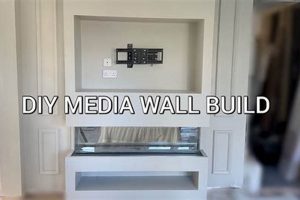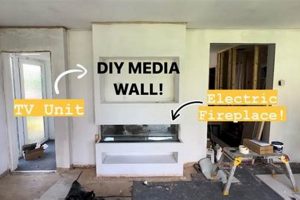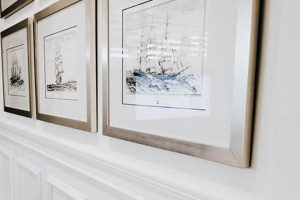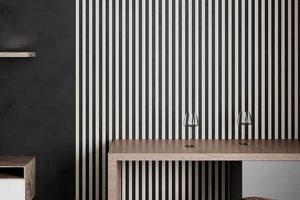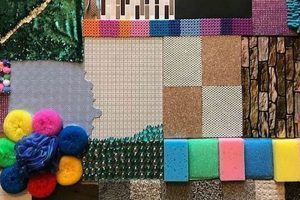The practice of constructing a self-made support system for suspending a stringed instrument on a vertical surface can be defined as a do-it-yourself guitar wall mounting project. An example would involve utilizing wood, metal, or plastic components, along with basic tools, to fabricate a device specifically designed to hold a guitar securely against a wall.
This method of instrument storage offers several advantages. Vertically displaying the instrument protects it from potential damage caused by accidental falls or being stepped on, freeing up valuable floor space. Historically, musicians have employed various creative solutions to store and showcase their instruments, with the increasing availability of materials and online resources popularizing the accessible approach of crafting personalized mounting solutions.
Further discussion will delve into the materials required, the design considerations for ensuring instrument safety, the step-by-step construction process, and the factors influencing the longevity and aesthetic appeal of these individualized solutions.
Essential Guidance for Self-Made Instrument Supports
The following guidelines are provided to ensure the successful and secure implementation of a self-constructed guitar support system.
Tip 1: Material Selection: Prioritize inert materials for the yoke (instrument contact area) to prevent chemical reactions with the guitar’s finish. Felt, cork, or specialized instrument-safe foam are recommended.
Tip 2: Structural Integrity: Calculate the load-bearing capacity of the chosen materials. A solid wood or metal frame is typically required to support the instrument’s weight. Consider wall stud location for secure anchoring.
Tip 3: Yoke Design: Ensure the yoke design securely cradles the guitar’s neck without applying excessive pressure. A “U” shape with adequate depth and width is generally effective.
Tip 4: Mounting Hardware: Utilize appropriate screws or bolts designed for the wall material (drywall, plaster, wood). Employ anchors when securing to drywall to distribute the weight effectively.
Tip 5: Clearance Considerations: Account for sufficient space between the instrument and the wall to prevent the guitar’s hardware (tuning pegs, strap buttons) from contacting the surface.
Tip 6: Leveling and Alignment: Employ a level during installation to guarantee the instrument hangs straight. Precise alignment ensures even weight distribution and prevents potential stress on the guitar’s neck.
Tip 7: Safety Inspection: Regularly inspect the support system for signs of wear or loosening hardware. Address any issues promptly to prevent instrument damage.
Adhering to these principles promotes both the longevity of the instrument and the reliability of the mounting system. Careful planning and execution are paramount.
The next section will address common challenges encountered during the fabrication process and effective troubleshooting techniques.
1. Safety
The integration of safety measures into self-fabricated instrument support systems is paramount, representing a critical factor in preventing potential damage to valuable instruments and ensuring user wellbeing. A poorly constructed or improperly installed support introduces significant risk, ranging from minor cosmetic blemishes to catastrophic falls resulting in irreparable damage. The causal relationship is direct: inadequate safety considerations during the design and construction phases directly translate into an increased likelihood of instrument damage or personal injury. For instance, using insufficiently strong materials or failing to secure the mount to a structural wall stud can lead to the support system’s collapse under the weight of the instrument.
Furthermore, the material selection for the yoke, the portion in direct contact with the instrument, necessitates careful consideration. Many guitars possess delicate finishes, particularly those employing nitrocellulose lacquer, which can react adversely with certain synthetic materials. A non-inert yoke material can cause discoloration, softening, or even permanent bonding to the instrument’s finish. As a practical example, using unsealed rubber or certain plastics for the yoke can lead to irreversible damage to a nitrocellulose-finished guitar neck, diminishing its value and aesthetic appeal. The selection of appropriate mounting hardware is equally important; employing drywall anchors rated for significantly less weight than the instrument poses a substantial risk.
In summary, prioritizing safety in the context of self-made guitar wall mounts necessitates meticulous planning, careful material selection, and precise installation techniques. Overlooking these aspects introduces unacceptable risks to both the instrument and the user. While aesthetic considerations are valid, they must never supersede the fundamental requirement of a secure and chemically inert support system. Failure to do so renders the undertaking inherently flawed and potentially detrimental.
2. Materials
The selection of appropriate materials constitutes a foundational element in the successful execution of a self-constructed guitar wall mounting project. The materials chosen directly influence the structural integrity, longevity, and aesthetic properties of the finished product, as well as its potential impact on the instrument it is intended to support. Careful consideration must be given to the physical and chemical properties of each component.
- Wood Selection
Hardwoods such as oak, maple, or walnut are frequently employed for the primary structural elements of the mount. These woods offer superior strength and resistance to bending or cracking under sustained load. Softwoods, while easier to work with, generally lack the necessary rigidity and are less suitable for load-bearing applications. The type of wood selected dictates the overall stability and durability of the mount, influencing its ability to safely support the instrument over time. For example, using pine for a long-necked bass guitar could result in sagging or eventual failure of the mount.
- Yoke Composition
The yoke, the component in direct contact with the guitar’s neck, requires materials that are both non-abrasive and chemically inert. Felt, cork, or specialized instrument-safe foams are commonly used to prevent scratching or chemical reactions with the guitar’s finish. Certain plastics and rubbers can react negatively with nitrocellulose lacquer, a common finish on many guitars, causing discoloration or damage. The choice of yoke material is critical for preserving the aesthetic and structural integrity of the instrument’s neck. Employing a rubber compound not rated for contact with nitrocellulose could lead to permanent marring of the instrument’s finish.
- Fasteners and Hardware
The selection of appropriate screws, bolts, and anchors is essential for securely attaching the mount to the wall. The type of fastener required depends on the wall construction (drywall, plaster, wood studs). Drywall anchors are often necessary to distribute the weight of the instrument over a larger surface area when studs are not readily accessible. Using undersized or inappropriate fasteners can compromise the stability of the mount and create a safety hazard. A lag bolt screwed directly into a wood stud provides significantly greater holding power than a small screw inserted into drywall alone.
- Finishes and Adhesives
Any finishes applied to the wooden components of the mount should be non-reactive and compatible with the guitar’s finish. Water-based finishes are generally preferred over solvent-based finishes, as they are less likely to cause damage or discoloration. Adhesives used to bond different materials together should be strong and durable, capable of withstanding the sustained stress of supporting the instrument’s weight. Epoxy resins or high-quality wood glues are commonly employed for this purpose. The use of inappropriate or low-quality adhesives can lead to structural failure of the mount over time.
The careful selection and combination of these materials are vital for constructing a safe, durable, and aesthetically pleasing guitar wall mount. A holistic approach, considering the interplay between each component and its potential impact on the instrument, is essential for ensuring a successful outcome. Neglecting any of these aspects can compromise the integrity and longevity of the entire system.
3. Design
In the context of self-fabricated guitar wall mounts, design constitutes a pivotal determinant of functionality, aesthetics, and, critically, instrument safety. The design phase directly dictates the structural integrity of the mount, influencing its capacity to support the instrument’s weight without risk of failure. An inadequately designed mount may exhibit insufficient load-bearing capacity, leading to sagging, breakage, or ultimately, the instrument falling. Conversely, a well-considered design incorporates reinforcement strategies, material selection informed by weight calculations, and secure attachment mechanisms, mitigating the potential for structural compromise. For example, a design incorporating a wider base plate and strategically placed support struts provides greater stability compared to a minimalist design lacking these features. The yoke design, the component cradling the guitar’s neck, demands particular attention. A poorly shaped or inappropriately sized yoke may exert undue pressure on specific points of the neck, potentially leading to warping or finish damage. A well-designed yoke distributes the instrument’s weight evenly across a larger surface area, minimizing stress concentration.
Further design considerations include the instrument’s accessibility and visual presentation. The mount’s orientation and angle affect the ease with which the instrument can be removed and replaced. An ergonomic design prioritizes user convenience without compromising security. Aesthetically, the mount’s design contributes to the overall visual appeal of the space. The choice of materials, finishes, and overall form factor can complement the instrument and the surrounding dcor. For instance, a minimalist design utilizing natural wood tones may blend seamlessly into a contemporary setting, while a more ornate design may serve as a focal point in a room. Practical application of sound design principles can be seen in commercially available guitar hangers, which often incorporate features such as auto-locking mechanisms to prevent accidental dislodgement, and adjustable yokes to accommodate various neck sizes. Mimicking these features in a homemade design significantly enhances the mount’s functionality and safety.
In summary, design represents a critical nexus point in self-made guitar wall mounts, influencing structural integrity, instrument safety, user convenience, and aesthetic integration. The challenges inherent in designing and constructing a safe and functional mount underscore the importance of careful planning, informed material selection, and precise execution. A thorough understanding of design principles is essential for mitigating potential risks and maximizing the benefits of this approach to instrument storage and display. Neglecting the design phase can lead to compromised safety, reduced functionality, and diminished aesthetic appeal, ultimately detracting from the overall value of the project.
4. Installation
Installation, within the context of self-fabricated guitar wall mounts, represents the critical phase where design intentions materialize into a functional support system. Improper installation directly undermines the structural integrity and intended safety features of the mount, regardless of the sophistication of the design or the quality of materials employed. A failure to correctly install the mount introduces significant risks, ranging from gradual loosening and instability to catastrophic detachment, potentially resulting in irreversible damage to the instrument. The relationship is causal: deficient installation practices directly contribute to compromised safety and reliability of the guitar support system. For instance, neglecting to locate and anchor the mount to a wall stud concentrates the instrument’s weight on the drywall alone, which possesses insufficient shear strength to provide adequate long-term support. Over time, this can lead to the drywall anchors pulling free, causing the mount and guitar to fall.
Furthermore, incorrect leveling during installation can induce uneven weight distribution, placing undue stress on specific points of the guitar’s neck. This can potentially lead to gradual warping or distortion over extended periods. Additionally, the type of hardware used during installation must be carefully matched to both the wall material and the weight of the instrument. Using undersized screws or inappropriate anchors compromises the mount’s ability to withstand the sustained load. For example, utilizing standard drywall screws instead of lag bolts to secure a heavy bass guitar mount to a wood stud significantly reduces the holding power of the connection, increasing the likelihood of failure. Adherence to manufacturer specifications for anchor installation, including pilot hole size and torque settings, is paramount to ensuring their proper function. Neglecting these details can compromise the anchor’s ability to expand and grip the drywall effectively.
In summary, proper installation constitutes an indispensable component of a successful “guitar wall hanger diy” project. It directly translates design intentions into a tangible, safe, and reliable support system for the instrument. Neglecting the principles of correct installation, including locating wall studs, using appropriate hardware, ensuring level alignment, and adhering to manufacturer specifications, significantly increases the risk of instrument damage and compromises the overall effectiveness of the project. The installation phase should therefore be approached with meticulous attention to detail and a thorough understanding of structural mechanics.
5. Compatibility
Within the domain of self-constructed guitar support systems, compatibility assumes a role of critical importance, influencing both the immediate functionality and the long-term preservation of the instrument. Compatibility, in this context, encompasses the alignment between the guitar’s physical characteristics and the design parameters of the self-made hanger. A lack of compatibility manifests as an inability of the hanger to securely and safely support the instrument, potentially resulting in damage. This incompatibility can stem from several factors, including mismatched neck dimensions, inadequate weight-bearing capacity, or adverse material interactions between the hanger and the guitar’s finish. For instance, a hanger designed for a standard electric guitar neck may prove unsuitable for a classical guitar with a wider neck profile, leading to an insecure fit and increased risk of slippage. Similarly, a hanger constructed from materials that react negatively with a nitrocellulose finish can cause irreversible damage to the instrument’s lacquer.
Further considerations regarding compatibility extend beyond mere physical fit. The hanger’s design must also accommodate the instrument’s weight distribution. A poorly balanced hanger may place undue stress on specific points of the guitar’s neck or body, potentially leading to warping or structural damage over time. Real-world examples of compatibility issues abound. A hanger with an insufficiently deep yoke may allow the guitar to easily dislodge, particularly if bumped or jostled. A hanger with metal components lacking protective padding may scratch or dent the instrument’s finish. The practical significance of understanding compatibility lies in the ability to proactively mitigate these risks. By carefully assessing the guitar’s dimensions, weight, and finish composition, and tailoring the hanger design accordingly, the constructor can ensure a secure, stable, and non-damaging support system. This process often involves iterative adjustments and modifications to the initial design to achieve optimal compatibility.
In summary, compatibility represents a fundamental prerequisite for a successful self-made guitar wall hanger. Failure to adequately address compatibility concerns can lead to instrument damage, reduced functionality, and compromised safety. The challenges associated with achieving optimal compatibility underscore the importance of thorough planning, meticulous execution, and a deep understanding of both the instrument’s characteristics and the properties of the materials used in hanger construction. Prioritizing compatibility is therefore essential for safeguarding the instrument and realizing the full potential of the DIY approach.
6. Maintenance
Sustained functionality and instrument safety within the realm of self-constructed guitar support systems are directly contingent upon consistent and appropriate maintenance procedures. The absence of regular maintenance can compromise the structural integrity of the mount, potentially leading to instrument damage or even catastrophic failure. A proactive maintenance regimen is therefore essential for ensuring the longevity and reliability of these DIY solutions.
- Hardware Inspection
Periodic inspection of all fasteners (screws, bolts, anchors) is crucial. Vibration, temperature fluctuations, and the sustained weight of the instrument can cause these components to loosen over time. A loose fastener compromises the mount’s stability, increasing the risk of the instrument falling. Real-world examples include screws gradually backing out of wall studs or drywall anchors losing their grip. Retightening loose hardware and replacing damaged components are essential corrective actions. Neglecting this aspect can lead to gradual degradation of the mount’s structural integrity and eventual failure.
- Material Condition Assessment
The materials used in the construction of the mount (wood, metal, padding) are subject to wear and degradation. Wood can warp, crack, or rot due to environmental factors. Metal components can corrode. Padding materials, such as felt or foam, can compress or deteriorate over time, reducing their protective qualities. Regular assessment of material condition allows for early detection of potential problems. Replacing worn or damaged materials ensures continued functionality and prevents damage to the instrument. For example, replacing compressed felt padding on the yoke prevents the guitar’s finish from coming into direct contact with the underlying support structure.
- Weight Load Monitoring
Over time, the weight load on the mount can cause subtle shifts or adjustments in its position. This can be particularly problematic if the mount is not perfectly level or if the wall studs are not optimally aligned. Periodically checking the mount’s levelness and ensuring that the instrument is hanging properly is important. Corrective actions may involve slightly adjusting the mount’s position or adding shims to ensure even weight distribution. Neglecting weight load monitoring can lead to uneven stress on the guitar’s neck or body, potentially causing warping or structural damage.
- Surface Cleaning
Dust and debris can accumulate on the mount over time, potentially scratching the instrument’s finish or causing allergic reactions. Regular cleaning with a soft, dry cloth is recommended. Avoid using harsh chemicals or abrasive cleaners, as these can damage the mount’s finish or the instrument’s finish. Cleaning also allows for closer inspection of the mount for signs of wear or damage that might otherwise go unnoticed. For example, removing dust buildup can reveal hairline cracks in wooden components or early signs of corrosion on metal parts.
These facets of maintenance, when consistently applied, contribute significantly to the long-term viability and safety of self-made guitar support systems. Proactive maintenance not only safeguards the instrument but also extends the lifespan of the mount itself, maximizing the value and utility of the DIY effort. The interplay between design, materials, installation, and maintenance is crucial, as even the most meticulously designed and constructed mount can fail if neglected. Regular upkeep is therefore an integral and indispensable component of the “guitar wall hanger diy” endeavor.
Frequently Asked Questions Regarding Self-Fabricated Instrument Supports
The following questions address common concerns and misconceptions surrounding the construction and implementation of do-it-yourself guitar wall mounting solutions. These answers are intended to provide clarity and guidance for those considering this approach.
Question 1: Is the creation of a self-made guitar support system truly cost-effective compared to commercially available options?
The cost-effectiveness of a self-fabricated support hinges primarily on the availability of existing tools and materials, as well as the complexity of the chosen design. If specialized tools must be purchased or premium materials are selected, the overall cost may exceed that of a commercially available mount. However, if utilizing readily available resources, a cost reduction is typically achievable.
Question 2: What is the minimum level of skill required to construct a safe and functional guitar wall mount?
A basic understanding of woodworking or metalworking techniques is generally required, along with proficiency in using hand tools and power tools safely. Familiarity with load-bearing principles and material properties is also beneficial. Complex designs may necessitate more advanced skills and experience.
Question 3: How can potential damage to the guitar’s finish be minimized when using a self-made mount?
The selection of chemically inert materials for the yoke, the portion in direct contact with the instrument, is paramount. Felt, cork, or specialized instrument-safe foams are recommended. Additionally, ensuring a smooth, burr-free surface on all contact points is crucial to prevent scratching or abrasion.
Question 4: What are the key considerations for determining the appropriate weight-bearing capacity of a DIY guitar mount?
The weight of the guitar, including any accessories, must be accurately determined. The load-bearing capacity of the chosen materials must then be calculated, taking into account safety margins. Wall stud location and the type of mounting hardware used also play a significant role in determining the overall weight capacity of the system.
Question 5: How frequently should a self-made guitar wall mount be inspected for signs of wear or damage?
A visual inspection should be conducted at least monthly, paying close attention to fastener tightness, material condition, and any signs of stress or cracking. More frequent inspections may be necessary in environments subject to significant temperature or humidity fluctuations.
Question 6: What are the potential legal liabilities associated with constructing and using a self-made guitar wall mount?
The constructor assumes responsibility for ensuring the safety and reliability of the mount. In the event of instrument damage or personal injury resulting from a faulty mount, the constructor may be held liable. Adhering to established safety standards and exercising due diligence in design and construction is essential to mitigate potential legal risks.
In summary, self-fabricating an instrument support necessitates meticulous planning, careful material selection, and diligent maintenance to ensure both instrument security and user safety. Addressing these aspects effectively mitigates potential risks.
The following section will delve into the aesthetic considerations involved in designing and finishing a custom guitar wall mount.
Conclusion
The foregoing examination of guitar wall hanger diy has illuminated critical facets ranging from material selection and structural design to installation protocols and ongoing maintenance. Each element contributes significantly to the safety and longevity of the instrument support system. A failure to adequately address any of these areas introduces potential risks that compromise the security and preservation of valuable instruments.
The decision to engage in the self-fabrication of an instrument support system necessitates a commitment to rigorous adherence to sound engineering principles and a comprehensive understanding of material properties. The pursuit demands precision and a dedication to safety, recognizing that the integrity of the final product rests solely upon the constructor’s diligence and expertise. Prudence dictates a thorough assessment of one’s capabilities before embarking on this endeavor.


